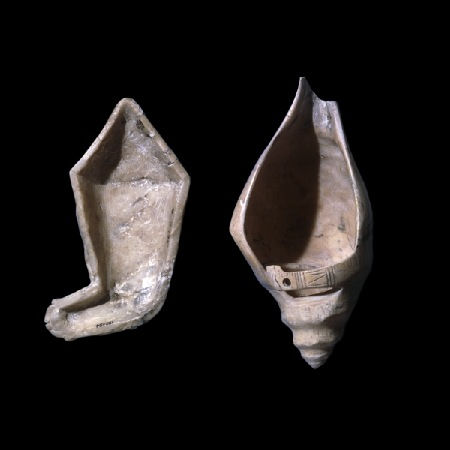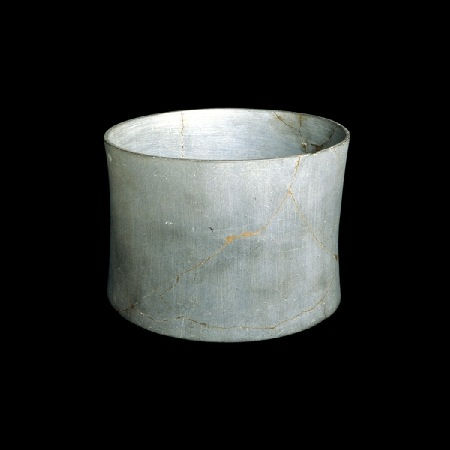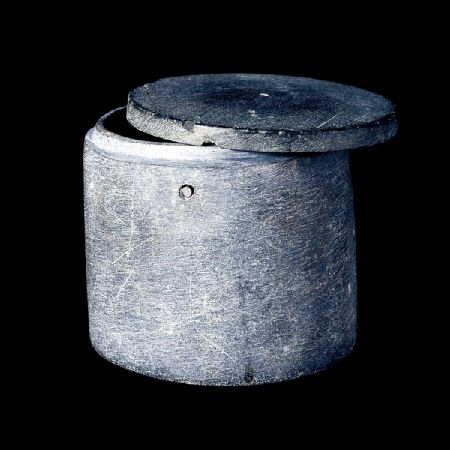
Sumerian Shakespeare
Vessels: Royal Tombs of Ur
Gold drinking tumbler. It looks like gold, but it's actually electrum, a naturally occurring alloy of gold and silver. Height: 15.2 cm (6 inches). I did some minor touch-up on this photograph to repair some of the damage on the interior of the cup. Enlarge.
The bottom of the tumbler shown above.
* * * Click on any image. If an enlargement is available, it will display in a separate window. * * *
Silver "lamp." Leonard Woolley thought this was an oil-burning lamp, but it's actually a pouring vessel, probably used for pouring libations during religious ceremonies. Notice the eight‑pointed rosette, the same one pictured on the bottom of the tumbler. Silver tumblers similar to the gold one were also found in The Royal Tombs of Ur, with the same rosette design. The rosette symbol is thought to have special (perhaps magical) significance for the Sumerians. The motif occurs frequently in their art, jewelry, and items of daily use. Diameter: 10.3 centimeters (approx. 4 inches).


The rosette squares on the Royal Game of Ur were considered lucky.
Silver decanter. Height: 22 cm (8.66'').


Another vessel thought by Woolley to be a silver "lamp," but it's probably a vessel used for pouring liquids. It's in the general shape of a conch shell. Length 16.7 cm (6.6 inches).
Spouted silver pitcher. It was found on the floor of the pit in Queen Pu-abi's grave, near the remains of a large chest that contained fifteen fluted silver tumblers (similar to the gold one pictured at the top of the page) nested into each other in groups of five. It may have been used as a wine decanter at banquets. Height: 19.5 cm (7.66 inches). Diameter 12.7 cm (4.92 inches).
Carved stone pouring vessel featuring a recumbent man-headed bull. Several examples of this type of vessel were found in the Royal Tombs. See an alternative view.
Another carved stone pouring vessel, in the form of a shell, featuring a reclining bull-man.
The reverse side of the vessel shown above, and another shell used for pouring liquids.

An electrum "pouring shell" of similar design to the stone shell on the above left and the silver shell near the top of the page.

Two "pouring shells" that are actually made of shell.
Gold cosmetic shell. When found, it is still contained remnants of pigmented eyeshadow. Many of the female retainers in the Great Death Pit had these cosmetic shells.

Lid of a small cosmetic box: belonging to Queen Pu-abi. It depicts a lion attacking a ram. See the box additionally enlarged.
Carved chlorite double bowl. Height: 3.700 cm. Length: 10.600 cm. (1.45 x 4.17 inches).
Bowl and strainer, used for wine or beer. They look like silver in this black and white photo, but they're actually made of gold (electrum), as shown in the inset and below:
Spouted gold bowl. Height 8 cm (3.15 inches). See a high-resolution color photograph
of the strainer.

Two travertine jars. Travertine is a form of limestone deposited by mineral springs. It often has a fibrous or concentric appearance and exists in white, tan, and cream-colored varieties. Travertine is most often used as a building material (e.g., the Roman Colosseum).
Left: Height:10 cm (3.94 inches). Diameter: 7.5 cm. (2.95 inches). Enlarge.
Right: Height: 20.32 cm (8 inches). Diameter: 27 cm. (10.63 inches). Enlarge.
Stone basin. This kind of soft stone was not indigenous to Sumer and had to be imported from distant regions. The fact it was found in the rich tomb of Queen Pu-abi suggests that these kinds of items were luxury goods. Height: 19.300 cm (7.6 inches). Diameter: 26.70 cm (10.5 inches).
Stone jar with lid. There are four holes in the top of the jar, which were probably used to secure the lid with a string through a hole in the center of the lid. Dia: 11 cm (4.33 inches).

Carved stone jars, found in the ancient city of Jiroft, in southeastern Iran. The similarity of these jars with those found in the Royal Tombs of Ur demonstrates the extensive network of trade that was maintained by the Sumerians and their distant neighbors.
Carved steatite jar. Height: 9.200 cm (3.6 inches). Diameter: 11.430 cm. (4.5 inches).
Decorative stone jar. "Such ancient Mesopotamian vessels may have originally contained luxury products, and indeed must have been considered as precious objects themselves, since they are generally found in temples, rich graves and palaces." (excerpt from the British Museum). Height: 10.2 cm (4 inches). Diameter 18.5 cm (7.28 inches).

Carved stone jar.

Tall travertine jars.
Left: Height: 13.25 cm. (5.22 inches). Diameter: 7.5 cm. (2.95 inches). Enlarge.
Right: Height: 19.05 cm. (7.5 inches). Diameter: 8.9 cm. (3.50 inches). Enlarge.
Multi-chambered calcite box. H: 8 cm, L: 16 cm, W: 15.3 cm (3.15 x 6.3 x 6 inches). The holes in the side were used to secure a lid to the box with string.

Calcite jar, found near the grooms in the burial pit of Queen Pu-abi.
Calcite pouring vessel. Height: 16 cm (6.3 inches). See another vessel of the same material
Various calcite vessels, including a jar similar to the one pictured below:
Calcite jar. Height: 26 cm (10.24 inches)
Marble vase (jar), belonging to Queen Pu-abi. Height: 15.000 cm (5.9 inches).
Copper basket (or bucket).
Ostrich egg bowls: Many of these bowls were found in the Royal Tombs of Ur. However, because of their fragile nature, very few of them were in good enough condition to be restored.

This "ostrich egg bowl" is actually made of gold. It is inlaid with shell, lapis lazuli, and red limestone. See a much enlarged image of the vase.
Obsidian bowl. Obsidian is volcanic glass. It was most often used for making arrowheads and cutting tools. It is easy to chip into a rough form, like an arrowhead, but it's difficult to carve into a smooth thin-walled structure, like this bowl. The manufacture of this bowl required considerable artistry and technical expertise. It belonged to Queen Pu-abi. Height: 6.000 cm (2.36 inches). Length: 16.500 cm (6.5 inches).
Stone bowl. Made of calcite. The walls of the bowl are so thin as to be translucent. The bowls found in the Royal Tombs of Ur are of a much higher quality than those found in other burial sites. Height: 12.500 cm (4.92 inches). Diameter: 23.000 cm (9.84 inches)
Calcite bowl. Like the bowl seen above, it was crushed when found and had to be reconstructed. Length: 22 cm, Width 13.5 cm (8.66 x 5.3 inches).
Lapis lazuli cup from the death pit of Queen Pu-abi. Height 6.7 cm (2.64 inches). See a high resolution picture of the cup
Silver bowl with bull leg symbol. This symbol is also on a spear point found in the Royal Tombs of Ur. The meaning of the symbol isn't known. Width: 12.38 cm. (4.87 inches). Length: 21.27 cm.(8.38 inches). Height: 7.62 cm. (3 inches).
Silver bucket. It was cut down from a larger size. "The sides divide at one point into two sheets of metal hammered over one another and fastened by rivets." (excerpt from the British Museum). Height: 17.78 cm. (7 inches). The diameter of the body is the same dimension.
Electrum cup. It was used to hold green eyeshadow, like the cosmetic shells seen above. Diameter: 10.160 cm (4 inches). Height: 8.890 cm (3.5 inches).

Carved shell, with a scene of Anzud, the lion-headed eagle, attacking a bullman.
Gold bowl, belonging Queen Pu-abi. It was found next to her body. Inside the bowl was a silver straw, used for drinking beer (apparently the foam on top of Sumerian beer wasn't very savory, and the dregs on the bottom had to be avoided). Height: 7.000 cm. Length: 19.70 cm. Width: 11.00 cm. (2.75 x 7.75 x 4.33 inches). See another picture of the bowl.
Gold cup. This gold cup was one of four vessels (including the electrum cup) found on the floor of the Queen's Grave, lying near the sacrificial victims. The handle is hollow and it was used as a straw, probably for drinking beer. See an alternative view of the cup. Although it appears to be round, it is surprisingly narrow when shown from the side. Height: 12.380 cm (4.87 inches).
Golden bowl, made of a gold and copper alloy. The photo expands beautifully when enlarged. Length: 13.1 cm. Width: 9.4 cm (5.16 x 3.7 inches).
The engraved underside of the bowl. Enlarge.
Continue the tour to: Jewelry or go to: Exploration Lyres Miscellaneous Weapons





































